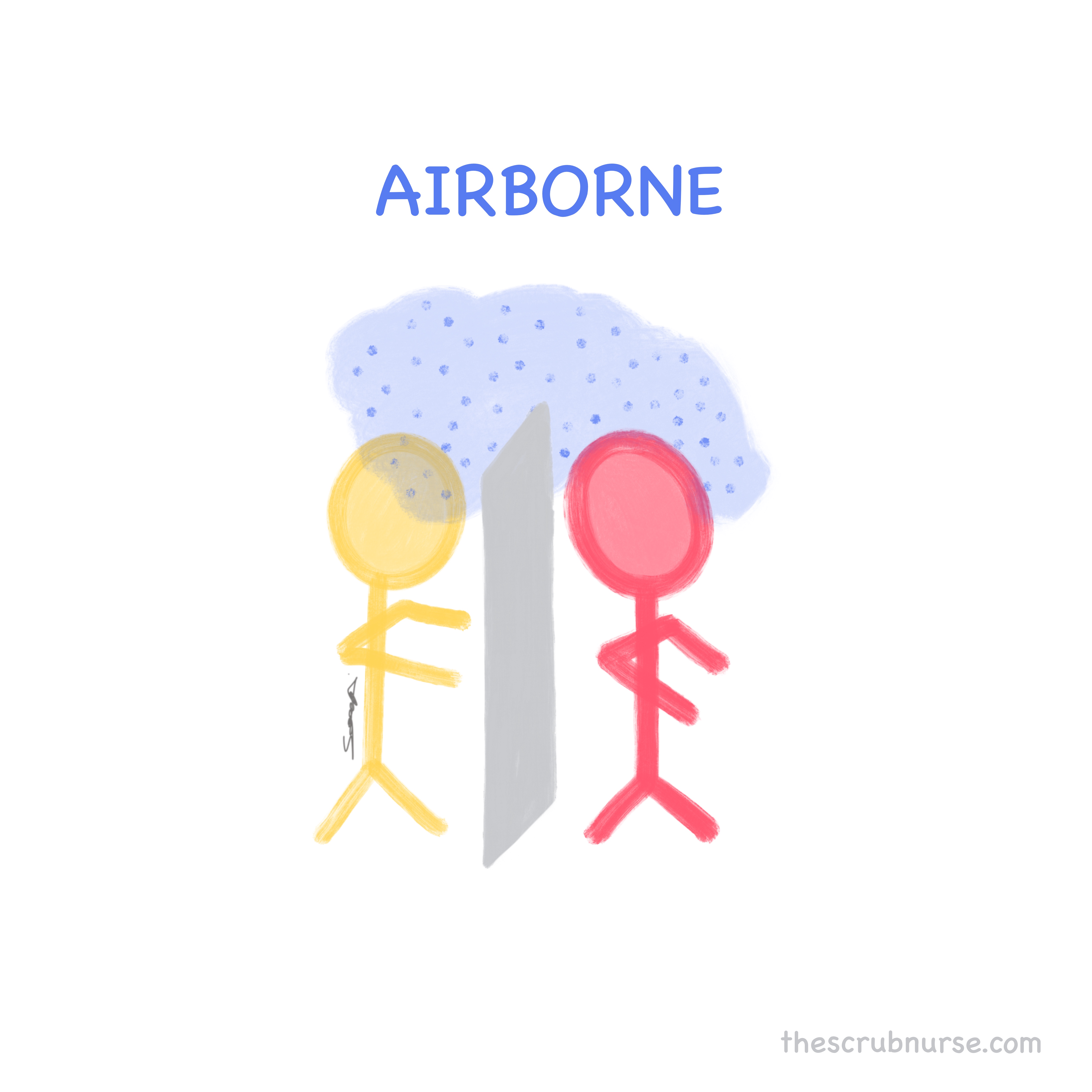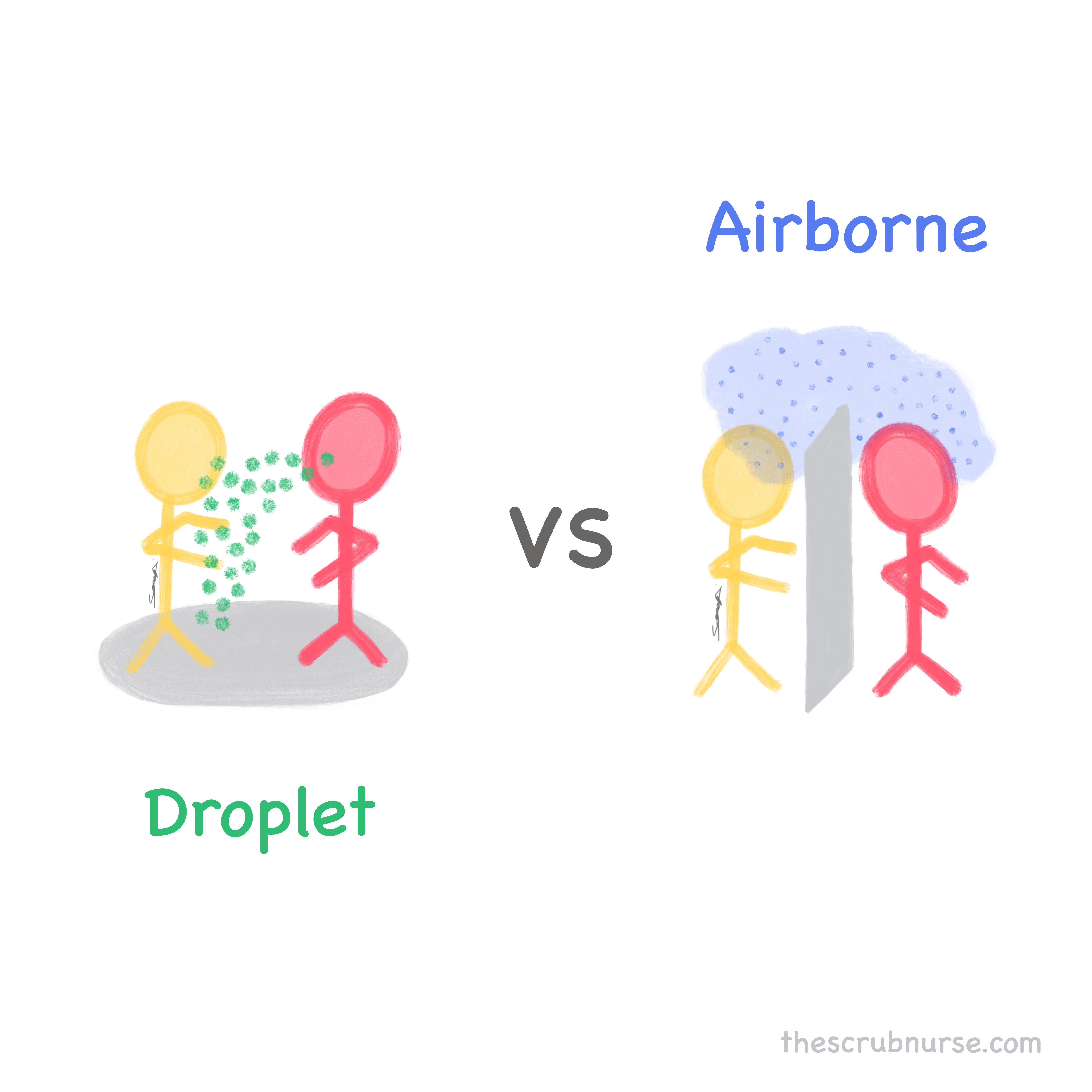Germs are everywhere
Some of them live in our body helping us to stay healthy. Others invade our body and multiply, provoking a body reaction. This is when infection occurs.
Infectious microorganisms can be transmitted in various ways, and they depend on external elements to transmit infection, as germs do not move themselves.
This article focusses in the spread of respiratory infections and the difference between Droplet and Airborne transmission.
Note1: airborne transmission can also be referred as aerosol transmission.
Note2: Micrometre = micron = µm
What are the main differences between Droplet and Airborne transmission?
Respiratory particles can be classified as being droplets or aerosols (fine droplets) based on particle size and their aerodynamic behaviour.
According to the WHO and the CDC, infections transmitted by particles larger than 5 µm are considered droplet transmission and infections transmitted by particles 5 µm or smaller are considered aerosol transmission. However, there is still some debate in the literature about the exact particle size limit used to differentiate between droplets and aerosol transmission.
Both droplets and aerosols can be generated during coughing, sneezing, talking or exhaling. The difference is that large droplets settle rapidly, whereas small aerosols can remain airborne and travel over longer distances by airflow.
As for the respiratory tract, aerosols are more likely to be inhaled deeply into the lower respiratory tract (affecting the lungs and alveolar tissues), while larger droplets will remain trapped in the upper airway. For this reason, infections caused by aerosols can lead to more serious illnesses.
Droplet and airborne Transmission
Droplet transmission occurs when respiratory droplets are expelled from an infected person onto the mucosal surfaces of a susceptible person. These mucous membranes are the eyes, nose and mouth – commonly known as a T-zone.
Aerosol transmission occurs when infected aerosols are inhaled by a susceptible person. Aerosols can be generated by two different ways:
- Directly from fine respiratory droplets expelled from an infected person,
- During a medical Aerosol-Generating Procedure (AGP) performed on the infected person.
According to Roy and Milton, airborne transmission can be classified into:
- Obligate – when transmission only occurs solely through aerosols
- Preferential – when transmission occurs through multiple routes but predominately through aerosols
- Opportunistic – when transmission occurs predominately through other routes but may also occur in special circumstances through aerosols in the opportunistic aerosol transmission.
Droplet and Airborne Transmission-Based Precautions: Personal Protective Equipment (PPE) for Healthcare professionals
Standard Precautions are used for all patient care and they are based on a risk assessment to protect healthcare providers and prevent spread of infection.
However, when patients are infected or colonized with a specific infectious agent, extra precautions are required in addition to the standard precautions already in place. These additional precautions are called Transmission-Based Precautions and are classified as contact, droplet, and airborne, depending on the transmission of the infectious agent.
Please note that some diseases have multiple routes of transmission and more than one Transmission-Based Precautions may be employed.

Droplet Transmission-Based Precations
According to CDC recommendations
- Put a mask on the patient to control source of infection
- Isolate the patient in a single room, if possible
- Follow Respiratory Hygiene/Cough Etiquette (*)
- Don mask (surgical or procedure mask) upon entry into the patient room or patient space.
- Also apply the standard precautions , as recommended for all patients. Particularly, use adequate PPE to protect the mucous membranes of the eyes, nose and mouth during tasks that are likely to generate splashes or sprays of blood, body fluids, secretions and excretions.
- Transporting and moving patients out of the room should be limited to medically necessary purposes
- If it is necessary for the patient to leave the room, instruct patient to wear a mask and follow Respiratory Hygiene/Cough Etiquette (*)

Airborne Transmission-Based Precations
According to CDC recommendations
- Put a mask on the patient to control source of infection
- Isolate the patient in an airborne infection isolation room (AIIR)
- If at the time AIIR is not available, place patient in a private room with the door closed to decrease the risk of airborne transmission
- Follow Respiratory Hygiene/Cough Etiquette (*)
- Don a fit-tested N95 or higher level respirator before patient room entry
- Also apply the standard precautions, as recommended for all patients. Particularly, use adequate PPE to protect the mucous membranes of the eyes, nose and mouth during tasks that are likely to generate splashes or sprays of blood, body fluids, secretions and excretions.
- Susceptible healthcare personnel must be restricted from entering the patient room, if other immune healthcare personnel is available
- Immunise susceptible people as soon as possible after unprotected contact with vaccine-preventable infections
- Transporting and moving patients out of the room should be limited to medically necessary purposes
- If it is necessary for the patient to leave the room, instruct patient to wear a mask and follow Respiratory Hygiene/Cough Etiquette (*)
(*) Respiratory Hygiene/Cough Etiquette includes:
- Cover mouth and nose with a tissue when coughing or sneezing;
- Use in the nearest waste receptacle to dispose of the tissue;
- Perform hand hygiene after having contact with respiratory secretions and contaminated objects/materials.
References
- CDC – How Infections Spread https://www.cdc.gov/infectioncontrol/spread/index.html
- CDC – 2007 Guideline for Isolation Precautions: Preventing Transmission of Infectious Agents in Healthcare Settings https://www.cdc.gov/infectioncontrol/pdf/guidelines/isolation-guidelines-H.pdf
- Current Opinion-Infectious Diseases – Controversy around airborne versus droplet transmission of respiratory viruses: implication for infection prevention https://emcrit.org/wp-content/uploads/2020/03/tada2019.pdf
- Henry the Hand Foundation – https://www.henrythehand.com/
- The Northern Ireland Regional Infection Prevention and Control Manual – Transmission based precautions https://www.niinfectioncontrolmanual.net/transmission-based-precautions
- BMC Infectious Diseases – Recognition of aerosol transmission of infectious agents: a commentary https://bmcinfectdis.biomedcentral.com/articles/10.1186/s12879-019-3707-y
Video references:
- Dr. John Campbell – https://www.youtube.com/watch?v=F1JEbx9NY2I&t=323s
- Professor Kim Woo-joo from Korea University Guro Hospital – https://www.youtube.com/watch?v=gAk7aX5hksU&feature=youtu.be&fbclid=IwAR2rWKOyMmK9I8TV03GKa8sAPcJi3ufLlDxXFg_XkTymeRJ9NDurriDeOwo
- Registered Nurse RN – https://www.registerednursern.com/standard-and-isolation-precautions-nclex-review/?fbclid=IwAR1j5M6FIiv-CC8-PdyekPBC4uD7XDfpKGnZJM7xXagkLoC-jhGou9ca6lQ



I am very much grateful for your efforts put on this article.
This guide is translucent, updated and very informative. Can I
expect you will post this sort of some other article in near future?
Best regards,
Demir Griffin
Thank you Demir. That’s great. I will be posting more posts in the future. 🙂